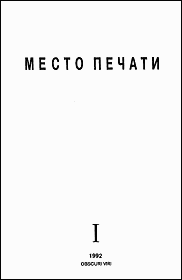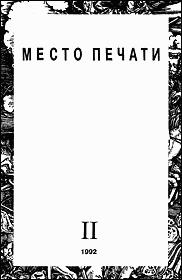

|
MESTO PECHATI, No 1-2
МЕСТО ПЕЧАТИ, NN 1-2 english text В первом в втором номере журнала "Место Печати", в отличие от всех остальных, нет предуведомления от редакции, поясняющего структуру построения номера. В первом и втором номере мы еще не были уверены, стоит ли вносить такие разъяснения. Тем более, не очевидно, что стоит это делать postfactum, особенно если перед потенциальным читателем откроется лишь содержание. Тем не менее, пояснения общего характера вряд ли испортят впечатление от "анонсированных" номеров, поэтому, в двух словах: Первый номер был посвящен переходному этапу в судьбе текста - уже не самиздат, тем более, что "Место Печати" никогда не связывало себя с подобными упражнениями, и, что было гораздо более актуально - уже не bookart. Но еще и не слишком полноценный продукт Гуттенберга - отсюда нарочитая промежуточность - пограничность - переход -трансформация - вот тот маршрут, по которому выстраивался номер. Указанные темы присутствуют в каждом разделе, но по логике событий , концентрируются в последних разделах. С темой расставания с bookart'ом связаны и такие формальные элементы дизайна, как нарочито небрежная верстка - строка не выключена по правому краю, поля неразумно большие и т.д. Этой же темой объясняется избыточное присутствие иллюстрация художников, работающих в области bookart'а: Звездочетов, Кисина, Тишков, Габриадзе. Более того, их иллюстрации взяты непосредственно из bookart'овских книг, а кроме всего, последний раздел представляет тексты Кисиной и Тишкова, смешивая окончательно строгие водоразделы: автор текста-текст-иллюстрация-автор иллюстрации. Тишков и Кисина соединяют последние звенья этой цепи, провоцируя короткое замыкание и конец (смерть),т.е. окончательный переход в другое состояние уже всего номера. Во втором номере все несколько проще - он посвящен 70-м годам - с их идеалами, массмедиальными кумирами, косвенными и пря ыми проблемами связаны все тексты номера, все вызываемые авторами персоналии: от Маркузе и Холмса, до параллельного кино и Скрябина. Вот, собственно и все, что следовало бы знать аккуратному читателю "Места Печати". Далее, с третьего номера, все войдет в привычную колею и Россия обвенчается с Германией. The first and second issues of ╚Mesto Pechati╩ magazine do not have the editorial introduction (as in all other issues) with explanation of the publication▓s structure. There was not enough clear whether such an intriduction is needed. It is not obvious if there▓s a need to make it post factum, however some words wouldn▓t spoil the impression of these two issues. The first issue was dedicated to the transition period in the text▓s fortune - not a samizdat already (considering that ╚Mesto Pechati╩ never excercised it), and, whaqt is even more important, not a book-art. Yet not a complete Guttembergian product, therefore an ostentatious intermediate - borderline - transition - transformation character, that▓s the way the issue is designed by. The mentioned themes appear in every chapter, though logic of the issue concentrates them in the final chapters. Parting with book-art shows up in formal design elements: deliberately loose layout. Hence an excessive use of illustrations by the artists who worked in book-art: Zvezdochetov, Kissina, Tishkov, Gabriadze. Moreover, their illustrations are taken directly from the book-art books, and the last chapter presents the texts by Kissina and Tishkov, finally mixing up the strict divisions between the author of the text, the text, the illustration and the author of the illustration. Tishkov and Kissina link the ends of this chain, provoking the short circuit and the end (death), which means the final transition of the whole issue into a different dimension. More simple is the second issue - it is dedicated to the 70-s. Their ideals, mass media cult figures directly or indirectly influence the whole issue (themes range from Marcuse and Holmes to parallel cinema and Skriabin). That is almost all that an accurate reader of ╚Mesto Pechati╩ should know. Since the third issue everything will be structured in a regular way and Russia will marry Germany. |

|
Место печати, ╧ 1 (Obscuri Viri, Москва, 1992 год, 128 стр., тираж 500 экз.) содержание Раздел I Юрий Ханин. Шагреневая кость. Илья Лепихов. Музыкальная история. Дмитрий Суходольский. Репрезентативность как женская болезнь современной культуры. Раздел II Василий Кондратьев. Жизнь Андрея Николева (этюд с комментариями) Ирина Кулик. Лента Мебиуса. (отрывки из доклада для несостоявшейся конференции) Борис Юхананов. О Никите Михайловском. Раздел III Ольга Абрамович. Как пух от губ (из разговоров с Зельдовичем и Драгомощенко). Андрей Ковалев. Письмо московского любителя искусств к швейцарскому другу о Франсуа Буше и любви к искусству. Раздел IY Екатерина Андреева. Идея молодости и красоты в русском и советском искусстве. П. Нестерова. Советская авиация как параллельный метрополитен. Анна Ципенюк. Опыт прочтения букваря. Раздел Y Леонид Тишков. Даблоиды.(пьес ) Юлия Кисина. История Юты Биргер(роман) В оформлении использованы рисунки и тексты Константина Звездочетова, Юлии Кисиной, Резо Габриадзе, Леонида Тишкова. Mesto pechati, No 1 a magazine of interpretation art (Obscuri Viri, Moscow, 1992, 128 pp, 500 copies) Section I An instructional text "Shagreen bone" the composer Yury Khanin. Ilya Lepikhov. An article about the attempts of the opera screen versions in silent films. Dmitry Sukhodolsky. Selfresententation as a female decease of modern culture. Section II Vasily Kondratiev. An essay about the poet Andrey Nikolev, an artist who outlived himself. Irina Kulik. An essay about self-destructing structure of a novel, taking as an example the antiformalistic Vaginov's prose. Boris Yuhananov. To the death of Nikita Mikhailovsky. Section III Olga Abramovich. From conversation with Zeldovich and Dragomostchenko. A letter to the Swiss friend from the Moscow fansier about Francois Boucher and love to art. Section IY Ekaterina Andreeva. Conception of youth and beauty in the Soviet totalitarian and contemporary art. P. Nesterova. Moscow Metro of the 30-s as a parallel aviation. Anna Tsipenyuk. An experience of reading the Soviet ABC - book. Section V Leonid Tishkov. Dabloids (a play in verse) Julia Kissina. The story of Utah Birger. (a novel) Edited by N.Sheptulin. Illustrations by Julia Kissina, Konstantin Zvezdochetov, Reso Gabriadze, Leonid Tishkov. |

|
Место печати, ╧ 2 (Obscuri Viri, Москва, 1992 год, 140 стр., тираж 500 экз.) Содержание Раздел I Михаил Трофименков. Альтернатива-Б Дмитрий Суходольский. Трикстер-XX (учение Маркузе как теневая идеология пост-советского искусства) Раздел II Сергей Кусков, Кирилл Преображенский. Лаборатория мерзлоты. О.А. С советским акцентом. Раздел III П.Нестерова. Кролик как лишний человек. Валисий Кондратьев. Мурзилка. Владимир Шухмин. Сто песен о Штирлице. Раздел III Павел Пепперштейн, Юрий Лейдерман (из шестой книги инспекции "Медицинская Герменевтика" "Идеотехника и рекреация") Скандал в Богемии. Пестрая лента. Собака Баскервиллей. Раздел IV Максим Пежемский. Переход товарища Чкалова через Северный полюс (сценарий) Приложение к 120-летию со дня рождения А.Н.Скрябина Юрий Ханин. Моя маленькая ханинская скрябиниана. А.Н.Скрябин. Записи. Mesto pechati, No 2 (Obscuri Viri, Moscow, 1992, 140 pp, 500 copies) a magazine of interpretation art Section I Mikhail Trofimenkov. An article about the factual opposition to the Soviet state cinematography in the 70-s. Dmitry Sukhodolsky. Marcuse doctrine as an under neathful ideology of the post philosophy of the post-soviet avantgarde. Section II Sergey Kuskov, Kirill Preobrazhensky. (The permafrost laboratory) The participants of a discussion focused on their own actions are trying to determine the new prototypes of the philosophy of creation. O.A. A draft about the different polygraphic process stages affecting the semantics of the text. Section III P.Nesterova. A rabbit as a needless man. Vasily Kondratiev. An imaginary story of a poete maudit. Vladimir Shukhmin. An essay devoted to the problem of the mythology reconstruction of the 70-s based on the phenomenon of popularity of the TV-serial about Soviet spy Stierlitz. Section IV Pavel Pepperstein, Yury Leiderman. Inspection "Medical Hermeneutics" (from book 6 "Ideotechnics and Recreation" ): Scandal in Bohemia. The adventure of the speckled band. The hound of Baskervilles. Section V Maxim Pezhemsky. Comrade Chkalov crosses the North Pole ( a screenplay). Addendum to the 120-th anniversary of Alexander Skriabin's birth Yuru Khanin. My little Khanin's Skriabinship Alexander Skriabin. Texts. Edited by N.Sheptulin |
| INDEX | GALLERY | PUBLICATIONS |